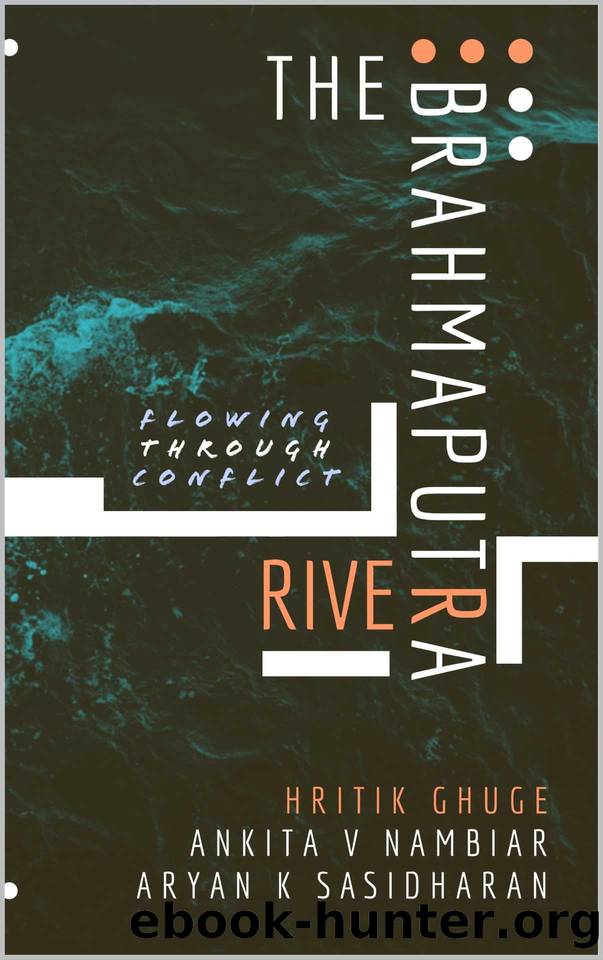The Brahmaputra River: Flowing through Conflict by Hritik Ghuge & Ankita Nambiar & Aryan Sasidharan

Author:Hritik Ghuge & Ankita Nambiar & Aryan Sasidharan [Ghuge, Hritik]
Language: eng
Format: mobi
Published: 2020-09-27T00:00:00+00:00
CHAPTER 5
INDO-BHUTAN RELATIONS
India and Bhutan share a relatively stress-free relationship when it comes to the sharing of water resources. Bhutan, the upper riparian, is home to the source of many of the Brahmaputraâs tributaries.
Figure 5.1: Transboundary Rivers from Bhutan to India (Britannica)
Albeit, the river does not flow through Bhutan, it is a part of the Brahmaputra basin. There are four major rivers in Bhutan: the Torsa, Sankosh, Wangchu, and the Manas. Other rivers, such as the Jaldhaka, Mao, Badnadi and the Dhansiri originate from the lesser Himalayas within Bhutan. The major rivers travel north to south, from Bhutan into India until they finally join the Brahmaputra. They have a combined estimated potential of 30,000 MW. The river Manas alone has a hydel potential of 20,000 MW. With a per capita water availability of 75,000 m3, Bhutan is one of the most water abundant nations in the region. The massive hydroelectric potential is highly appealing to India, as it currently produces around 1600 MW, out of which the majority is exported to India, a country with growing clean energy demand.
HISTORY OF INDIA-BHUTAN RELATIONSHIPS
India and Bhutanâs current relationship is essentially one of hydroelectricity generation. India aids and assists the construction of hydro projects in Bhutan, and then buys its power. Bhutan is undoubtedly Indiaâs closest friend in its neighbourhood. India has aided in Bhutanâs development ever since its independence in 1949, is the main donor to its Five-year Plans since 1961. One of the key elements of their friendship is the Treaty of Friendship signed in 1949, granting India a key role in Bhutanâs foreign policy matters, and is providing a basis for free trade and economic cooperation between the two nations.
Bilateral cooperation between the two nations in the water sector dates back to 1955. Indiaâs Ministry of External Affairs sponsored a scheme for flood warning measures in India. The ministry sent 19 rain gauge stations and 8 wireless stations, all setup, to the Royal Government of Bhutan. A Joint Group of Experts on Flood Management observe the effects of flooding and erosion in the foothills of Bhutan and India, the lower riparian. In 1979, a Joint Experts Team was set up to prevent the recurrence of floods on shared rivers.
Download
This site does not store any files on its server. We only index and link to content provided by other sites. Please contact the content providers to delete copyright contents if any and email us, we'll remove relevant links or contents immediately.
The Lonely City by Olivia Laing(4568)
Animal Frequency by Melissa Alvarez(4150)
All Creatures Great and Small by James Herriot(3986)
Walking by Henry David Thoreau(3681)
Exit West by Mohsin Hamid(3634)
Origin Story: A Big History of Everything by David Christian(3472)
COSMOS by Carl Sagan(3346)
How to Read Water: Clues and Patterns from Puddles to the Sea (Natural Navigation) by Tristan Gooley(3239)
Hedgerow by John Wright(3106)
How to Do Nothing by Jenny Odell(3101)
The Inner Life of Animals by Peter Wohlleben(3099)
How to Read Nature by Tristan Gooley(3077)
Project Animal Farm: An Accidental Journey into the Secret World of Farming and the Truth About Our Food by Sonia Faruqi(3018)
Origin Story by David Christian(2991)
Water by Ian Miller(2950)
A Forest Journey by John Perlin(2915)
The Plant Messiah by Carlos Magdalena(2745)
A Wilder Time by William E. Glassley(2689)
Forests: A Very Short Introduction by Jaboury Ghazoul(2671)
